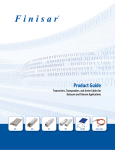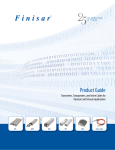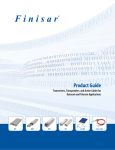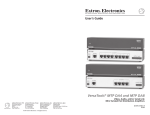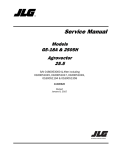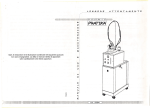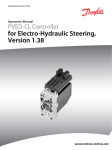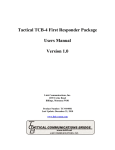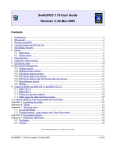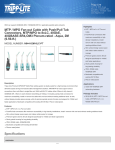Download Arista Networks 10m, QSFP+
Transcript
40G Cabling Technical Q&A Document Arista 40G Cabling and Transceivers: Q&A 40Gigabit Cables and Transceivers Q. What 40G cables and transceivers are available from Arista? A. Arista supports a full range of both copper cables and optical transceivers for 40GbE, compliant to the IEEE standards. For copper both QSFP+ to QSFP+ (40G to 40G) and QSFP+ to SFP+ (40G to 4x10G) cables enable short reach options. For longer distances Arista offers a wide range of optical transceivers for various fiber types and reach requirements. Product Number Product Description 40GbE Transceivers QSFP-40G-SR4 QSFP-40G-XSR4 QSFP-40G-UNIV QSFP-40G-PLRL4 QSFP-40G-PLR4 QSFP-40G-LRL4 QSFP-40G-LR4 40GBASE-SR4 QSFP+ transceiver, up to 100m over parallel OM3 or 150m over OM4 multi-mode fiber 40GBASE-XSR4 QSFP+ transceiver, up to 300m over parallel OM3 or 400m over OM4 multi-mode fiber 40G Universal QSFP+ transceiver, up to 150m over duplex OM3 or OM4 fiber, 500m over duplex single-mode fiber 40G QSFP+ optic, up to 1km over parallel SMF (4x10G LR up to 1km) MTP-12 40G QSFP+ optic, up to 10km over parallel SMF (4x10G LR up to 10km) MTP-12 40GBASE-LR4 QSFP+ transceiver, up to 1km over single-mode fiber 40GBASE-LR4 QSFP+ transceiver, up to 10km over single-mode fiber 4 x 10GbE QSFP+ to 4 x SFP+ Twinax Copper Cables CAB-Q-S-0.5M 4 x 10GbE QSFP+ to 4 x SFP+ twinax copper cable, 0.5M CAB-Q-S-1M 4 x 10GbE QSFP+ to 4 x SFP+ twinax copper cable, 1M CAB-Q-S-2M 4 x 10GbE QSFP+ to 4 x SFP+ twinax copper cable, 2M CAB-Q-S-3M 4 x 10GbE QSFP+ to 4 x SFP+ twinax copper cable, 3M CAB-Q-S-5M 4 x 10GbE QSFP+ to 4 x SFP+ twinax copper cable, 5M 40GbE QSFP+ to QSFP+ Twinax Copper Cables CAB-Q-Q-0.5M 40GbE QSFP+ to QSFP+ twinax copper cable, 0.5M CAB-Q-Q-1M 40GbE QSFP+ to QSFP+ twinax copper cable, 1M CAB-Q-Q-2M 40GbE QSFP+ to QSFP+ twinax copper cable, 2M CAB-Q-Q-3M 40GbE QSFP+ to QSFP+ twinax copper cable, 3M CAB-Q-Q-5M 40GbE QSFP+ to QSFP+ twinax copper cable, 5M CAB-Q-Q-7M 40GbE QSFP+ to QSFP+ twinax copper cable, 7M 40GbE QSFP+ to QSFP+ Active Optical Cables AOC-Q-Q-40G-3M AOC-Q-Q-40G-5M AOC-Q-Q-40G-7M AOC-Q-Q-40G-10M AOC-Q-Q-40G-15M AOC-Q-Q-40G-20M AOC-Q-Q-40G-25M AOC-Q-Q-40G-30M AOC-Q-Q-40G-50M AOC-Q-Q-40G-75M AOC-Q-Q-40G-100M www.arista.com QSFP+ to QSFP+ 40GbE Active Optical Cable 3 meter QSFP+ to QSFP+ 40GbE Active Optical Cable 5 meter QSFP+ to QSFP+ 40GbE Active Optical Cable 7 meter QSFP+ to QSFP+ 40GbE Active Optical Cable 10 meter QSFP+ to QSFP+ 40GbE Active Optical Cable 15 meter QSFP+ to QSFP+ 40GbE Active Optical Cable 20 meter QSFP+ to QSFP+ 40GbE Active Optical Cable 25 meter QSFP+ to QSFP+ 40GbE Active Optical Cable 30 meter QSFP+ to QSFP+ 40GbE Active Optical Cable 50 meter QSFP+ to QSFP+ 40GbE Active Optical Cable 75 meter QSFP+ to QSFP+ 40GbE Active Optical Cable 100 meter 1 40G Cabling Technical Q&A Document Additional optics and cables may be released in future. Q. What is the 40GbE max supported distances? A. The IEEE 40GBASE-X standard describes the following: • • • • 40GBASE-SR4 supports up to 100m on OM3, and 150m on OM4. There is no support for OM2 or OM1 (these are considered legacy). 40GBASE-LR4 supports up to 10km on 9u SM fiber (same fiber used for 10G single mode 10GBASE-LR). 40GBASE-CR4 supports up to 7m. The maximum is a limitation of the copper technology, and may not be realistic in all environments. 40GBASE-KR4 specifies up to 1m for backplane technology - this is not applicable to Arista switches and is designed for server blade systems running 40GbE over a backplane Q. What is the 40GbE XSR4 max supported distances? A. The Arista extended reach SR4 (XSR4) supports distances compatible with 10GBASE-SR, up to 300m on OM3 and 400m on OM4. The 40G XSR4 is also capable of running as 4x10G, with full compatibility with 10G-SR and 10G-SRL transceivers. Operation in 4x10G mode will require either a fiber breakout cable, or a QSFP-LC cassette. See below for details. Q. What is the 40G UNIV distance capability? A. The Arista 40G Universal QSFP (UNIV) transceiver works with both duplex multi-mode and duplex single mode fiber. It supports distances up to 150m over OM3 or OM4 multi-mode fiber and up to 500m over single mode fiber. For more details visit http://go.aristanetworks.com/l/12022/201407-14/ms14r/12022/109548/QSFP_40G_UNIV_FAQ.pdf Q. What is the 40GbE PLRL4 distance capability? A. The Arista parallel LR4 Lite (PLRL4) supports distances compatible with 10GBASE-LRL, which is 1km on single mode fiber. In addition the PLRL4 optic can support 4 individual 10G-LR connections using a 4x10G mode and fiber breakout cables or cassettes for single mode fiber. Q. What is the 40GbE PLR4 distance capability? A. The Arista parallel LR4 (PLR4) supports distances compatible with 10GBASE-LR and 10GBASE-LRL, which is 10km (or 1km) on single mode fiber. In addition the PLR4 optic can support 4 individual 10G-LR connections using a 4x10G mode and fiber breakout cables or cassettes for single mode fiber. Q. What cable type is needed for the PLRL4 and PLR4 transceivers? A. The PLR4 and PLRL4 use an MTP-12 connector, and require an APC (Angle polished connector) single-mode MTP-12 cable. The cable is equivalent to the 40G-SR4 MTP to MTP, with the only change being the use of single mode fiber. UPC (Ultra polished connector) is another type www.arista.com 2 40G Cabling Technical Q&A Document of connector for MTP-12 cables but this does not exist in the market for single-mode fiber. APC is the only available choice for single-mode MTP-12 fiber. Q. Can a customer use third party QSFP+ to QSFP+ and SFP+ cables? A. Arista does not restrict the use of third party copper cables. These cables need to comply with the IEEE specifications, to allow them to be correctly recognized by the Arista switch. Interfaces with cables not recognized correctly will be disabled. Q. What is the minimum bend radius of the 40G copper cables? A. The QSFP-SFP (4-way) CR4 cables have a stated minimum bend radius of 32.35mm (1.27”) to ensure they are not damaged. The QSFP-QSFP cables have a stated minimum bend radius of 45mm (1.77”) to ensure they are not damaged. [QSFP-QSFP cables are thicker than the QSFP-SFP ones and need more space.] Q. How does the QSFP+ to SFP+ fiber convertor allow 4x 10G? A. The IEEE 40G-SR4 standard specified a parallel technology, with 4 lanes in each direction. The purpose of this was to allow for easier development of 40G, re-using 10G components. As a side result the 40G multi-mode transceivers can also support 4x10G modes. (The switch or router also has to support this in both the hardware and software). A fiber that connects from one 40G port to four 10G ports provides a physical path to allow the source “40G” port running in 4x10G mode to be connected to 4 unique 10G destinations. As the fiber is a passive medium it has no concept of the 40G or 10G signals. Q. Where does a customer buy the special splitter cables? A. First, this is not really a special cable - it is an MTP-LC cable as shown below. This product is an 8f assembly with the polarity of the fibers in a specific order in order to provide the correct orientation of the fibers into the channels: A large number of cabling companies have the MTP-LC cables available and are supplying these in volume to customers. However, these are usually a special order, as the total cable length, tail lengths and cable polarity are customer selectable. As a result these are commonly considered as “special” but are in fact standard cables, custom ordered. www.arista.com 3 40G Cabling Technical Q&A Document In many existing DC environments LC-MTP cables are used to support high density fiber trunks between switches, rack patch panels and main distribution cabling panels (MDA) as shown below: An example cable diagram from Corning is shown below for an MTP12-4xLC harness assembly with a set of part numbers in the table below. 8 1 1 6 5 Key Up 4 3 12 TX RX SFP 4 TX RX SFP 3 TX RX SFP 2 TX RX SFP 1 12 QSFP Accepts Key Up Rx1 Rx2 Rx3 Rx4 x x x x Tx4 Tx3 Tx2 Tx1 7 2 1 Corning Part Number Description H757908QPH-KB010F 8-fiber harness; MTP (F) to (4) LC uniboot; Type-B polarity; OM4 and 50/125; 24-in. LC breakout and overall length of 10 ft 8-fiber harness; MTP (F) to (4) LC uniboot; Type-B polarity; OM4 and 50/125; 24-in. LC breakout and overall length of 20 ft 8-fiber harness; MTP (F) to (4) LC uniboot; Type-B polarity; OM4 and 50/125; 24-in. LC breakout and overall length of 30 ft H757908QPH-KB020F H757908QPH-KB030F The application for the above MTP-LC harness cable is to directly connect a QSFP+ port to (4) SFP+ ports. For most Data Center applications, the use of structured cabling is employed via MTPMTP trunks and the use of patch panels. For more detailed guidance on the applicable harness configuration and part number needed, please refer to the following document for more detailed information: http://csmedia.corning.com/CableSystems//Resource_Documents/application_engineering_notes_rl /AEN152.pdf www.arista.com 4 40G Cabling Technical Q&A Document Q. What is the specification for the MTP-LC cable? A. According to the IEEE 40GBASE-SR4 specifications, the 40G signal is carried over a single MTP-12 fiber, with only 8 of the 12 fibers used, where the remaining four are not used, and can optionally be not present in the cable (to save cost). The specific mapping of Tx and Rx ports to fiber strands is defined in the standard, with 1-4, and 9-12 used as shown below. This would be an MTP-12 to an MTP-12. Fiber Number 12 11 10 9 8–5 Transmit Channels: 1 2 3 4 Blank Receive Channels: Blank 4 3 2 1 4 3 2 1 To specify a cable that converts a 40G interface to 4 x 10G pairs the MTP-12 fibers are mapped according to the 40G-SR4 specifications, identifying that Tx1 and Rx1 are mapped as Pair-1, Tx2 and Rx2 as Pair 2, and continue for all 4 pairs. There are two different options for the cable to split MTP into LC - a straight through, or a crossover, to support different connections needs. To make sure that Tx is wired to Rx on the other end (a cross-over cable) the table below shows both the MTP strand color and position number, the LC leg / side and color. MTP Strand Color MTP Position # LC Leg / Side LC Strand Color Blue 1 1/B Blue Orange 2 2/B Orange Green 3 3/B Green Brown 4 4/B Brown Slate 5 NA Slate White 6 NA White Red 7 NA Red Black 8 NA Black Yellow 9 4/A Yellow Violet 10 3/A Violet Rose 11 2/A Rose Aqua 12 1/A Aqua If a “straight through” cable is required (as a X-over is already present in the path), then the above table should be modified, such that 1<->1A, 12<->1B and so on, etc. www.arista.com 5 40G Cabling Technical Q&A Document Q. What is the specification for the QSFP+ to QSFP+ cable? A regular MTP-12 to MTP-12 cable as shown below is also used for direct 40G to 40G connections. At the MTP ends there are 12 fibers (an MTP-12), and two guide pins (or sockets), which can be seen in the photograph below. Key Up Corning Part Number J757512QE8-NB010F J757512QE8-NB020F J757512QE8-NB030F Key Up Tx1 Tx2 Tx3 Tx4 x x x x Rx4 Rx3 Rx2 Rx1 QSFP Accepts Key Up 1 12 QSFP Accepts Key Up Rx1 Rx2 Rx3 Rx4 x x x x Tx4 Tx3 Tx2 Tx1 12 1 To directly connect two QSFP+ ports, the 12-fiber assembly uses a pinless MTP connector on both ends to interface with the QSFP+ ports on the switch (the pins are in the transceiver port). The example diagram below shows how fiber 1 (blue fiber) is in position 1 on one end and in position 12 on the other end. This positioning is required for transmit and receive to connect. The part numbers for this configuration are in the table below. Description 12-fiber jumper; MTP (F) to MTP (F); Type- B Polarity; OM4 50/125; overall length of 10 ft 12-fiber jumper; MTP (F) to MTP (F); Type- B Polarity; OM4 50/125; overall length of 20 ft 12-fiber jumper; MTP (F) to MTP (F); Type- B Polarity; OM4 50/125; overall length of 30 ft The application for the above MTP-MTP jumper cable is to directly connect a QSFP+ port to QSFP+ port. For most Data Center applications, the use of structure cabling is employed via MTPMTP trunks and the use of patch panels. For more detailed guidance on the applicable MTP jumper configuration and part number needed, please refer to the following document for more detailed information. Additional detail is included in the below document on solutions that enable increased fiber utilization: http://csmedia.corning.com/CableSystems//Resource_Documents/application_engineering_notes_rl /AEN151.pdf www.arista.com 6 40G Cabling Technical Q&A Document Q. Where else can the MTP-12 and MTP-24 cables be purchased? To enable customers to rapidly test and implement a whole variety of 40G and 100G interfaces a range of fiber cables can be ordered directly from Arista Networks. These cables come in a choice of 3m (12’) and 5m (15’), which addresses the most common lengths needed for small installations or when doing product evaluation and testing. Both single mode and multi-mode (OM4) are also available to match the wide range of 10G, 40G and 100G duplex and parallel technologies that are supported via Arista QSFP+ and MXP interfaces. The following table provides a reference to the cables available. The detailed specifications of each cable are available from Arista Networks account teams and include length of cable fan-outs, end-to-end patch information (key orientation and pinned/unpinned) and fiber mappings. Part Number CAB-M24PM24P-M5 Description Multimode OM4 Fiber - 5m lengths CAB-M24P3M12P-M5 CAB-M24P12LC-M5 CAB-M24PM24T-M5 CAB-M24P2M12T-M5 CAB-M12PM12P-M5 CAB-M12PM12T-M5 CAB-M12P4LC-M5 OM4 MTP24 to MTP24 - Direct connect for port to port (swaps the Tx and the Rx rows), 5m OM4 MTP24 to 3x MTP12 - Direct connect for 1x MTP SR12 to 3 QSFP+ SR4, 5m OM4 MTP24 to 12x LC - Direct connect for 1x MTP SR12 to 12 SFP+ SR, 5m OM4 MTP24 to MTP24 - Port to trunk, non-pinned to pinned, 5m OM4 MTP24 to 2x MTP12 - Port to 2x12 fiber trunks, non-pinned to pinned, 5m OM4 MTP12 to MTP12 - Direct connect for port to port (8 fiber cross over), 5m OM4 MTP12 to MTP12 - Port to trunk, non-pinned to pinned (8 fiber), 5m OM4 MTP12 to 4 LC - Direct connect for 1x QSFP+ SR4 to 4 SFP+ SR, 5m CAB-M12PM12P-S5 CAB-M12PM12T-S5 CAB-M12P4LC-S5 SM MTP12 to MTP12 - Direct connect for port to port (12 fiber cross over), 5m SM MTP12 to MTP12 - Port to trunk, non-pinned to pinned (8 fiber), 5m SM MTP12 to 4 LC - Direct connect for 1x QSFP+ PLRL4 to 4 SFP+ LR, 5m CAB-M24PM24P-M3 OM4 MTP24 to MTP24 - Direct connect for port to port (swaps the Tx and the Rx rows), 3m OM4 MTP24 to 3x MTP12 - Direct connect for 1x MTP SR12 to 3 QSFP+ SR4, 3m OM4 MTP24 to 12x LC - Direct connect for 1x MTP SR12 to 12 SFP+ SR, 3m OM4 MTP24 to MTP24 - Port to trunk, non-pinned to pinned, 3m OM4 MTP24 to 2x MTP12 - Port to 2x12 fiber trunks, non-pinned to pinned, 3m OM4 MTP12 to MTP12 - Direct connect for port to port (12 fiber cross over), 3m OM4 MTP12 to MTP12 - Port to trunk, non-pinned to pinned (8 fiber), 3m OM4 MTP12 to 4 LC - Direct connect for 1x QSFP+ SR4 to 4 SFP+ SR, 3m Single Mode Fiber - 5m lengths Multimode OM4 Fiber - 3m lengths CAB-M24P3M12P-M3 CAB-M24P12LC-M3 CAB-M24PM24T-M3 CAB-M24P2M12T-M3 CAB-M12PM12P-M3 CAB-M12PM12T-M3 CAB-M12P4LC-M3 Single Mode Fiber - 3m lengths CAB-M12PM12P-S3 CAB-M12PM12T-S3 CAB-M12P4LC-S3 SM MTP12 to MTP12 - Direct connect for port to port (12 fiber cross over), 3m SM MTP12 to MTP12 - Port to trunk, non-pinned to pinned (8 fiber), 3m SM MTP12 to 4 LC - Direct connect for 1x QSFP+ PLRL4 to 4 SFP+ LR, 3m Q. Are Arista branded cables Plenum rated? Yes, cables purchased from Arista (Arista branded cables) are plenum rated. www.arista.com 7 40G Cabling Technical Q&A Document Q. What other options are available apart from break-out cables? Using an MTP-LC fan-out with an MTP-12 at one end, a 40G interface can be adapted from one port of 40G into 4x10G and uses the same cabling to convert multiple 10G links into a single cable. In addition to using a fan-out cable, there are also a number of cabling system solutions that use a “cassette” style system to break out the MTP into individual LC pairs (as below - (1) MTP-12 into (6) LC pairs). For more information on various deployment methods for these cassettes in a QSFP+ to SFP+ deployment, refer to the following document: http://csmedia.corning.com/CableSystems//Resource_Documents/application_engineering_notes_rl/AEN152.pdf An additional solution for deployment of 40G (QSFP+) channels with increased fiber utilization is to use an MTP to MTP cassette system that converts 12-fiber MTPs to 8-fiber MTPs, as shown below. The above document provides guidance and detailed information on this deployment method as well. Q. Can the 40G-LR4 transceiver also be split into 4x10G connections? A. No, 40G-LR4 cannot be split into 4x10G. The 40GBASE-LR4 uses 4 lambdas (or wavelengths) on a pair of single mode fibers, and does not lend itself to “splitting” into 4 pairs without substantial complexity to split out the wavelengths. The unique characteristic of 40GBASE-SR4 is that it uses parallel (ribbon) fiber, which allows the creation of 4 fiber pairs. As an alternative single mode parallel 40G optics are available (40G-PLRL4 and 40G-PLR4) that do allow for splitting into 4x10G (single mode). Each of these optics is fully compatible with 10GBASELR and 10G-LRL up to the maximum distance of each optic, and use single mode MTP-12 ribbon fibers. www.arista.com 8 40G Cabling Technical Q&A Document Arista 40GbE Product Configuration: Q. How do you change the QSFP+ ports to support 10G or 40G mode? A. On all Arista switches with 40GbE ports the QSFP+ ports can support 4x10G or 1x40G on any port (independently configurable). By default the QSFP+ ports are setup as 4x10G as below: Et52/1 Et52/2 Et52/3 Et52/4 notconnect notconnect notconnect notconnect 1 1 1 1 evi full full full full 10G Not Present 10G Not Present 10G Not Present 10G Not Present To configure them for 1x40G mode use the command: (config)#int et 52/1 (config-if-Et52/1-4)#speed forced 40gfull You may see warnings if the transceivers are missing. ! Warning: Transceiver for interface Et52/1 is not present. ! Warning: Transceiver for interface Et52/2 is not present. ! Warning: Transceiver for interface Et52/3 is not present. ! Warning: Transceiver for interface Et52/4 is not present. Cannot verify compatibility of speed and duplex settings. Cannot verify compatibility of speed and duplex settings. Cannot verify compatibility of speed and duplex settings. Cannot verify compatibility of speed and duplex settings. The output of show commands will now reflect 40G as a speed. Et52/1 Et52/2 Et52/3 Et52/4 notconnect notconnect notconnect notconnect 1 1 1 1 full full full full 40G Not Present 40G Not Present 40G Not Present 40G Not Present Inserting a suitable 40G transceiver or cable will bring the ports up in the “40G” mode. The other end will be another 40G device. To configure the port for 4x10G mode reset it to the default and let it negotiate at 10G (config-if-Et52/1-4)#no speed Next, use the same optics with a splitter cable, and a 10G SFP+ (SR or SRL) at the other end. Alternatively using copper cables and swap the QSFP-QSFP for a QSFP-4SFP+. NOTE: In 4.7.x releases this required a platform command: switch(config)#platform trident qsfp mode 40G After this command the interfaces need to be shut/no shut. www.arista.com 9 40G Cabling Technical Q&A Document In 4.8 and later the command was deprecated. Q. How are the 7050Q shared QSFP+ ports changed to the SFP+ ports? A. By default the Arista 7050Q has the 8 SFP+ ports disabled, and they must be enabled before being used. There is a hardware command to activate the SFP+ ports, and disable the associated QSFP+ ports. SFP+ Ports 17-20 are associated with QSFP+ port 15/1-4 SFP+ Ports 21-24 are associated with QSFP+ port 16/1-4 The command to configure the mode: (config)#hardware port-group 1|2 select qsfp|sfp To activate Eth17-24 you need: (config)#hardware port-group 1 select Et15/1-4 | Et17-20 To activate Eth21-24 you need: (config)#hardware port-group 2 select Et16/1-4 | Et21-24 Using this command will restart the forwarding agent, which will cause all links in these port groups to flap. Proceed with caution if in a production environment. Using the QSFP+ ports, with a transceiver for 4x10G mode requires the same command as for the 7050-64 switches to enable 4x10G mode on the uplinks. www.arista.com 11/2014 10










